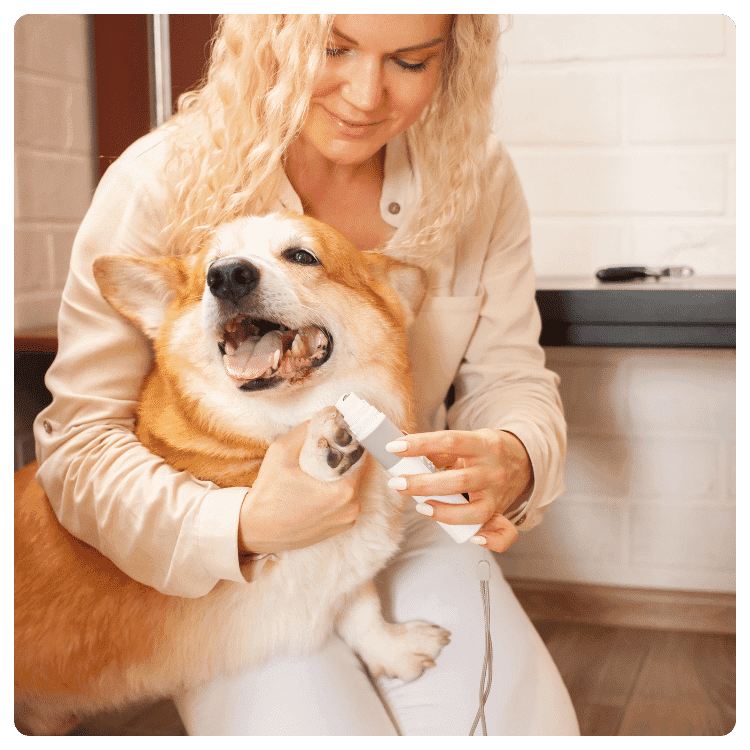Rabies is a viral disease that has caused widespread concern due to its severe impact on both animals and humans. Among domestic animals, dogs are the most commonly affected by rabies, which can have deadly consequences if not promptly treated. This blog aims to provide an in-depth understanding of how dogs get rabies, the symptoms, the progression of the disease, preventive measures, and the importance of vaccination. By the end of this article, you will have a comprehensive knowledge of rabies in dogs, which can help in safeguarding your furry friends and the community.
What is Rabies?
Rabies is a viral zoonotic disease caused by the rabies virus, which belongs to the Lyssavirus genus. The virus affects the central nervous system of mammals, leading to encephalitis (inflammation of the brain) and, ultimately, death if not treated early. Rabies is transmitted through the saliva of an infected animal, typically through bites. Once the virus enters the body, it travels along the peripheral nerves to the brain, where it replicates and causes severe neurological damage.
How Do Dogs Get Rabies?
1) Transmission of Rabies
Bite from an Infected Animal : The most common way dogs contract rabies is through the bite of an infected animal. The virus is present in the saliva of the rabid animal, and when it bites, the virus is introduced directly into the bloodstream of the dog.
Scratches and Open Wounds : Although less common, rabies can also be transmitted if the saliva of an infected animal comes into contact with scratches, abrasions, or open wounds on the dog’s skin.
Mucous Membranes : In rare cases, rabies can be transmitted if the infected saliva contacts the mucous membranes of the dog’s mouth, nose, or eyes.
2) Common Carriers of Rabies
While any mammal can carry rabies, certain species are more likely to be vectors, meaning they commonly transmit the virus. These include:
Wild Animals : Bats, raccoons, skunks, and foxes are the primary wild animals that carry rabies. These animals can come into contact with domestic dogs, especially in areas where wildlife is prevalent.
Domestic Animals : Unvaccinated cats, livestock, and other dogs can also be sources of rabies. It’s crucial to ensure all domestic animals are vaccinated to prevent the spread of the disease.
Risk Factors for Dogs
Several factors increase the risk of dogs contracting rabies:
Lack of Vaccination : Unvaccinated dogs are at a higher risk of contracting rabies if exposed to the virus.Roaming and Outdoor Access : Dogs that are allowed to roam freely, especially in areas where wild animals are present, have a higher risk of encountering rabid animals.Interaction with Wildlife : Dogs that frequently interact with wildlife or are used for hunting are at an increased risk of rabies.Geographical Location : Rabies is more prevalent in certain regions. Dogs living in areas with a high incidence of rabies in wildlife are at greater risk.
Symptoms of Rabies in Dogs
Rabies in dogs progresses through several stages, each with distinct symptoms. Recognizing these symptoms can be crucial for timely intervention.
1) Incubation Period
The incubation period is the time between the initial infection and the onset of symptoms. In dogs, this period can vary widely, typically ranging from two weeks to several months. During this time, the virus travels to the brain, and the dog appears healthy.
2) Prodromal Stage
The prodromal stage lasts for about 2-3 days and is characterized by subtle changes in behavior:
Behavioral Changes : Dogs may become unusually anxious, fearful, or agitated. Conversely, a normally aggressive dog might become unusually affectionate.Fever : Dogs may develop a mild fever.Pruritus (Itching) : Dogs might excessively lick or scratch at the bite site.
3) Furious Stage
The furious stage, also known as the excitative stage, lasts for 1-7 days. It is marked by extreme behavioral changes:
Hyperactivity : Dogs may become hyperactive and restless.Aggression : They may exhibit unexplained aggression, attacking objects, other animals, or people.Hydrophobia : Difficulty swallowing and an aversion to water are common due to spasms in the throat muscles.Disorientation : Dogs may appear disoriented and have difficulty moving.
4 ) Paralytic Stage
The paralytic stage, also known as the dumb stage, occurs after the furious stage and lasts for 2-4 days:
Paralysis : Dogs may experience paralysis beginning at the site of the bite and progressing throughout the body.Drooling and Difficulty Swallowing : Due to throat and jaw muscle paralysis, dogs often drool excessively and cannot swallow.Coma and Death : The disease ultimately leads to coma and death, typically within 7-10 days after symptoms appear.
Diagnosis of Rabies
Diagnosing rabies in dogs involves a combination of clinical observation and laboratory testing.
1) Clinical Observation
Veterinarians will observe the dog’s symptoms and behavioral changes. While these signs can strongly suggest rabies, they are not definitive without laboratory confirmation.
2) Laboratory Testing
Direct Fluorescent Antibody Test (DFA) : This test is the gold standard for diagnosing rabies. It involves taking a sample of brain tissue, which is then tested for the presence of rabies virus antigens using fluorescent antibodies.Polymerase Chain Reaction (PCR) : PCR can detect rabies virus RNA in various tissues, including saliva, skin, and nerve tissue. It is a sensitive and specific test used in some cases.Histopathology : Examination of brain tissue under a microscope can reveal characteristic changes caused by the rabies virus.
3) Post-Mortem Diagnosis
Unfortunately, definitive diagnosis of rabies usually occurs post-mortem because the necessary samples (brain tissue) can only be collected after death. However, recognizing symptoms early and initiating preventive measures can save lives.
Prevention of Rabies in Dogs
Preventing rabies in dogs primarily involves vaccination and responsible pet ownership.
1) Vaccination
Routine Vaccination : Dogs should receive their first rabies vaccine at around 12-16 weeks of age, followed by booster shots as recommended by a veterinarian. Typically, boosters are administered every one to three years.Vaccination of Other Animals : Ensuring other pets and livestock are vaccinated can also help prevent the spread of rabies to dogs.
2) Responsible Pet Ownership
Leash Laws and Supervision : Keeping dogs on a leash or in a secure, fenced area can prevent them from roaming and encountering rabid animals.Avoiding Wildlife : Prevent dogs from interacting with wild animals, especially in areas known for rabies outbreaks.Regular Vet Visits : Regular veterinary check-ups can help ensure dogs remain healthy and up-to-date on vaccinations.
3) Community Measures
Public Awareness : Educating the community about the importance of rabies vaccination and how to recognize symptoms can reduce the incidence of the disease.Rabies Control Programs : Many regions have rabies control programs that include vaccination drives, stray dog control, and public education initiatives.
Treatment for Rabies Exposure
If a dog is suspected of being exposed to rabies, immediate action is crucial.
1) Post-Exposure Prophylaxis (PEP)
Immediate Veterinary Attention : Take the dog to a veterinarian immediately. The vet will clean the wound thoroughly and administer a rabies booster vaccine if the dog’s vaccination status is up-to-date.Quarantine : Dogs that have been exposed to rabies and are not up-to-date on vaccinations may need to be quarantined for a period determined by local health authorities.
2) Post-Exposure Management
Monitoring : Monitor the dog closely for any signs of rabies during the quarantine period.Reporting : Report the exposure to local health authorities to aid in tracking and controlling rabies outbreaks.
The Importance of Rabies Control
Rabies control is vital for protecting public health and animal welfare.
1) Human Health
Prevention of Transmission : Effective rabies control in dogs reduces the risk of transmission to humans. Rabies is nearly always fatal once symptoms appear, so preventing exposure is critical.Public Safety : Educating the public about rabies and promoting responsible pet ownership can significantly reduce the incidence of rabies.
2) Animal Welfare
Reducing Suffering : Rabies causes significant suffering in affected animals. Preventing the disease through vaccination and control measures improves animal welfare.Preserving Wildlife : Controlling rabies in domestic animals can also help protect wildlife populations from the disease.
Conclusion Rabies is a deadly but preventable disease that poses a significant threat to dogs and humans alike. Understanding how dogs get rabies, recognizing the symptoms, and taking proactive measures for prevention are crucial steps in protecting your pets and community. Vaccination remains the most effective method of preventing rabies, and responsible pet ownership plays a vital role in controlling the spread of this disease. By staying informed and vigilant, we can work towards a world where rabies is no longer a threat to our beloved canine companions and ourselves.
Remember, if you suspect your dog has been exposed to rabies, seek immediate veterinary care and follow all recommended protocols. The health and safety of your dog and community depend on timely and appropriate action.
Frequently Asked Questions
1) Can rabies be cured in dogs?
Unfortunately, rabies is almost always fatal in dogs once symptoms appear. There is no effective cure for rabies after the onset of symptoms. The focus is on prevention through vaccination and immediate action after potential exposure.
2) How often should my dog be vaccinated against rabies?
Dogs should receive their first rabies vaccine at around 12-16 weeks of age, followed by a booster one year later. After that, boosters are typically given every one to three years, depending on local regulations and the specific vaccine used.
3) What should I do if I think my dog has been exposed to rabies?
If you suspect your dog has been exposed to rabies, seek immediate veterinary care. The vet will clean any wounds and may administer a rabies booster vaccine. Follow any quarantine recommendations from local health authorities.
4) What are the first signs of rabies in dogs?
Early signs of rabies in dogs include behavioral changes such as anxiety, aggression, or unusual friendliness, fever, and excessive licking or scratching at the bite site. These symptoms typically appear in the prodromal stage.
5) Can rabies be transmitted from dogs to humans?
Yes, rabies can be transmitted from dogs to humans through bites, scratches, or contact with infected saliva. It is crucial to seek medical attention immediately if bitten or scratched by a potentially rabid animal.
6) Are there any animals that cannot get rabies?
All mammals can get rabies, but some species are more commonly affected than others. Birds, reptiles, and amphibians do not get rabies.
7) Can indoor dogs get rabies?
While indoor dogs are at lower risk, they can still get rabies if they are exposed to a rabid animal, such as a bat that enters the home. It’s important to keep indoor dogs vaccinated and prevent them from interacting with wildlife.
8) Is rabies common in certain regions?
Rabies prevalence varies by region. It is more common in areas with large populations of wild animals known to carry the virus, such as bats, raccoons, skunks, and foxes. Certain countries have higher rates of rabies in dogs, while others have implemented successful control measures.
9) How long does it take for rabies symptoms to appear in dogs?
The incubation period for rabies in dogs typically ranges from two weeks to several months, depending on the location of the bite and the amount of virus introduced. Symptoms usually appear within one to three months after exposure.
10) What is the treatment for a dog that has been bitten by a potentially rabid animal?
Immediate veterinary care is essential. The wound should be cleaned thoroughly, and a rabies booster vaccine may be administered. The dog may need to be quarantined for observation, especially if its vaccination status is not current.
11) how long can a dog live with rabies?
Once clinical symptoms of rabies appear in a dog, the disease is nearly always fatal. The progression from the onset of symptoms to death typically occurs within 7 to 10 days. However, this timeframe can vary depending on factors such as the dog’s health, the strain of the virus, and the individual response to the infection.







